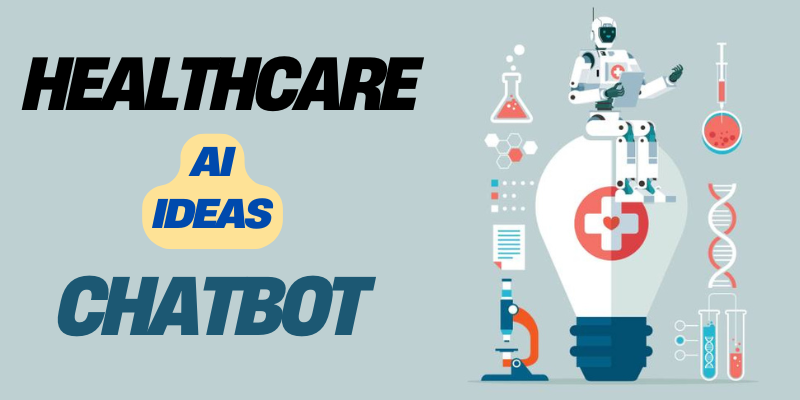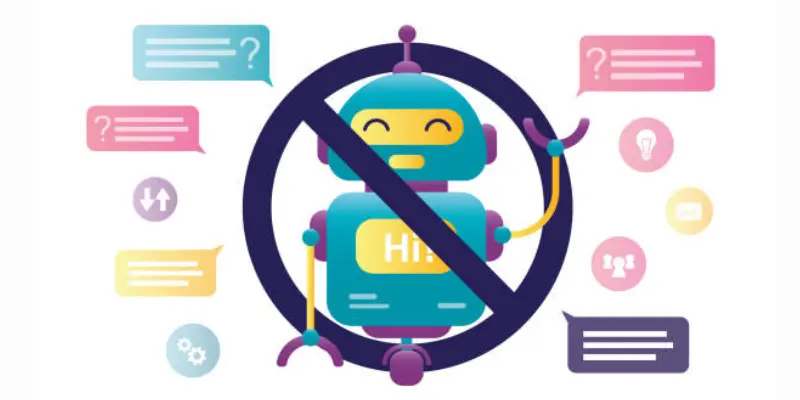AI Chatbot Projects in Healthcare for Students: Step by Step
Published: 23 Apr 2025
Are you struggling to find a healthcare project that’s both interesting and easy to build? Many students face this problem, especially when it comes to using AI. That’s why AI Chatbot Projects in Healthcare are a smart choice for students to take start. These are simple to create and also solve real healthcare problems.
In this guide, you will learn step by step how to create your own healthcare chatbot. Whether you are working on a school assignment or just want to try something new, this project can help you build something that matters a lot in healthcare.

What Is an AI Chatbot?
An AI chatbot is a smart computer program that talks to people. You type a question and it gives you a helpful answer just like chatting with a friend online.
In healthcare, these chatbots can answer health questions, remind people to take medicine or even help in booking doctor visits. They work using artificial intelligence, which means they learn how to understand and reply better over time.
Simple Example: When someone asks, “What should I do if I have a cold?” The chatbot gives quick tips like resting, drinking water and visiting a doctor if needed.
How Are AI Chatbots Used in Healthcare?
Across Europe, hospitals and clinics are using AI chatbots to help both patients and staff. These bots save time and make healthcare easier to access, especially when doctors are busy.
Here’s how they help:
- Answering health questions– Chatbots give fast, basic advice.
- Booking appointments– Some bots can check schedules and book visits.
- Reminding patients– They remind people to take medicine or follow routines.
- Mental health support– Some chatbots offer simple emotional support when someone feels stressed or anxious.
💡 Real-Life Example: In the UK, the NHS has used chatbots to help people check COVID-19 symptoms. In Germany, apps like Ada help users figure out what might be wrong based on how they feel.
These tools don’t replace doctors but they make it easier to get help quickly.
Why AI Chatbot Projects Are Perfect for Students
Students often come out from stress of studying too much in the schools, colleges and universities. They have knowledge and clear mindset but execution takes time and for some students this time period appears as a lifetime failure. So, as a newbie it’s important to find something which takes less time, less budget and more benefits. And AI chatbot projects in healthcare are perfect to get a start. Here is why it is helpful;
Builds Real-World Tech Skills
AI chatbot projects help you learn skills that are useful in real life. You don’t just read about AI, you build something with it.
Here’s what you learn:
- Basic coding: Even simple projects can teach you how to write chatbot replies.
- Problem solving Mindset: You think about how to help users with common health issues.
- Communication skills: You learn how to write clear and friendly answers for chatbot users.
Also Read: AI as Caregiver in Healthcare
Easy to Start With Free Tools
You don’t need expensive software or fancy equipment to build a chatbot. There are free tools online that work well for beginners.
Here are a few good ones:
- Dialogflow (by Google): Great for simple chatbot projects.
- Tidio: Easy drag and drop chatbot builder.
- Microsoft Power Virtual Agents: Free for students with school accounts.
Works for School Assignments or Competitions
Across Europe, students often need projects for school presentations, science fairs or coding contests. An AI chatbot is a great fit because:
- It solves a real problem in healthcare.
- It can be built in steps (so you can start small and grow).
- It shows that you understand technology and human needs.
Step by Step Guide to Building a Simple AI Chatbot for Healthcare
Let’s move forward and learn how to build a healthcare AI chatbot following simple and easy steps. Creating an AI chatbot might sound tricky but don’t worry it’s easier than you think. Just follow these steps and you will build something useful, perfectly made for students like you.

Step 1: Choose a Problem to Solve
Start by picking one small problem in healthcare. Don’t try to fix everything at once, it will cause problems.
Here are some ideas:
- A chatbot that reminds users to take medicine
- A chatbot that helps people check their symptoms
- A chatbot that gives mental health tips or calming messages
💡 Tip: Choose a problem that you care about. It makes your project more meaningful.
Step 2: Pick a Platform
You need a platform to build your chatbot. Luckily, many free platforms work well for beginners.
Here are some popular choices:
- Dialogflow (by Google)– Good for building smart bots with simple coding.
- Tidio– Works with drag and drop. Great for non-coders.
- Microsoft Power Virtual Agents– Free for students with school email accounts.
🌍 Note: These platforms support many European languages, great if you want your chatbot to speak German, French, Spanish or others.
Step 3: Design Your Chatbot Conversation
Before building, plan how your chatbot will talk. Use daily life wording in designing chatbot conversations.
Ask yourself:
- What questions will people ask?
- How should the chatbot reply?
- What tone should it use? (Friendly? Professional?)
✍️ Example:
User: “I forgot to take my pill. What should I do?”
Bot: “It’s okay! Please check with your doctor before taking another dose.”
Step 4: Build and Train the Chatbot
Now it’s time to build! Training your chatbot is the most important step in crafting a stunning healthcare AI chatbot. Train the chatbot on the conversation you entered in the first step.
- Open the platform you chose (like Dialogflow)
- Add the questions and answers you planned
- Use buttons or simple logic to guide the user
📝 Tip: Start small. Make sure one task works well like medicine reminders before adding more.
Step 5: Test It with Friends or Classmates
Once your chatbot is ready, test it. Fair testing helps you to stay ahead of the curve and build something that truly matters.
- Ask your friends, classmates or teachers to try it.
- Watch how they use it.
- Ask: “Was the answer clear? Was anything confusing?”
📖 Real-life Tip: Testing is part of every professional tech project, even at big companies across the world!
Step 6: Improve with Feedback
After testing, make small changes to fix any issues. Ask your friends, family members and teachers to provide honest reviews without hesitation.
By knowing the best results, You can:
- Add better replies
- Make the chatbot easier to use
- Add more languages if your users speak different ones
🚀 Encouragement: Each step you take brings your project closer to real world impact.
A more detailed article on How to Build an AI Chatbot from scratch without having coding knowledge.
Ideas of AI Chatbot Projects in Healthcare for Students
If you are not sure what kind of chatbot to build? Don’t worry, I am sharing some easy and creative ideas to get you started. These projects work well for school, college or even tech fairs.

Medicine Reminder Bot
This chatbot reminds people when to take their medicine.
Great for:
- Older adults who forget doses
- Busy students managing prescriptions
Example:
“Hi! It’s time to take your 8 AM blood pressure tablet. Don’t forget to drink water!”
Tip: Add simple “Yes, thank you” or “I already took it” buttons for quick replies.
Symptom Checker Bot
Helps users understand if their symptoms might need medical attention.
Great for:
- Cold, fever or allergy checks
- Guiding people to call a doctor if needed
Example:
“Do you have a cough with a high fever?”
*“Yes” → “You should contact your GP or local clinic.”
Note: Remind users that your bot is not a real doctor.
Mental Health Support Bot
A friendly bot that sends calming messages or wellness tips.
Great for:
- Stress relief during exams
- Daily mood check-ins
Example:
“Feeling anxious? Try a 2-minute breathing exercise. Want to begin now?”
Extra Tip: Use emojis or soft language to make it feel warm and caring.
Healthy Habits Coach
This chatbot gives tips for eating well, sleeping better and moving more.
Great for:
- Teenagers and young adults
- School wellness projects
Example:
“It’s almost lunchtime! Remember to include a fruit or veggie 🍎”
Add-on: Let users set daily health goals and get reminders.
First Aid Guide Bot
This bot gives simple first-aid steps during small emergencies.
Great for:
- School projects or Scout groups
- Users who want to learn safety basics
Example:
“What should I do for a nosebleed?”
“Sit up, lean forward and pinch your nose gently for 10 minutes.”
Important: Always add a line: “Call emergency services for serious injuries.”
Each of these ideas is simple to build and highly useful. You can even mix two ideas together like a healthy habits + mental wellness bot to make your chatbot more unique.
Common Mistakes Students Make (And How to Avoid Them)
Building an AI chatbot for healthcare is exciting. But many students, even smart ones, can make simple mistakes. Let’s look at three common mistakes and how you can avoid them.

Mistake: Choosing a Problem That’s Too Big
Some students try to solve everything with one chatbot. They want it to answer every health question, speak every language and help every user.
Why it’s a problem:
That’s too much for a small project. You will get stuck, feel stressed and maybe give up.
✅ Better choice:
Instead of “A chatbot for all diseases,” go with “A chatbot that reminds people to take their asthma inhaler and give them health tips for asthma.”
Mistake: Making It Too Complex at the Start
It’s tempting to add everything like buttons, voice replies and fancy graphics right from the beginning.
Why it’s a problem:
You will waste time on extras before your chatbot even works properly.
⚙️ Example:
Start with simple text replies like:
“Hi! What medicine reminder would you like to set today?”
Mistake: Forgetting to Test with Real People
Some students build the chatbot and think it’s done. But they never test it with others. It causes them to fail at the first big step. Test it with friends and random people and ask the following questions.
Why it’s a problem:
What makes sense to you might confuse someone else.
👂 Ask questions like:
- Was anything unclear?
- Did the chatbot understand your message?
- Was it helpful?
Avoiding these small mistakes makes a big difference. It saves time, reduces stress and helps you build something that really works. Whether you are in school in Germany, college in France or joining a tech fair in Spain, keeping an eye on these mistakes will really help you.
Tools and Resources to Help You Build Faster
Building a healthcare chatbot does not have to take forever. There are many free tools and resources available, especially for students online. Let’s go through some of the best options that will make your job easier.
Free Platforms to Build Your Chatbot
You don’t need to be a coding expert to build a chatbot. There are easy to use platforms that allow you to create one with minimal effort and too at a minimum price of totally free.
Here are a few top choices:
- Dialogflow (by Google)
Great for students who want to build smart chatbots. It’s user-friendly and free for basic plans. - Tidio
Easy drag and drop interface. Perfect if you prefer not to code at all. - Microsoft Power Virtual Agents
A free tool for students, and it’s great for integrating your bot with Microsoft services.
Most of these platforms also have European language support, so you can build bots in languages like German, French or Spanish.
Pre built Templates for Healthcare Chatbots
Some platforms offer templates that you can use right away. These are ready-made chatbots and all you need to do is adjust the settings and text according to your project’s needs.
- HealthBot (by Microsoft)
A pre-built healthcare chatbot that can answer health related questions. Just customize it to your needs. - ManyChat
Provides templates for creating chatbots that help with reminders and healthcare tips. Very beginner-friendly.
Templates save you time and give you a solid starting point.
AI Resources to Help You Learn More
Want to learn more about how AI and chatbots work? Here are some great resources:
- Coursera
Offers free courses on AI, machine learning and chatbot building. Great for expanding your skills. - YouTube Tutorials
There are thousands of YouTube tutorials focused on building chatbots in healthcare. Look for creators who teach in simple, clear steps. - AI in Healthcare Blogs
Check out blogs like HealthITAnalytics or AI in Healthcare. They often discuss new trends and chatbots in healthcare, helping you stay updated. Subscribe us, we also share content on AI in Healthcare.
Many of these resources offer free certificates that can look great on your CV or resume.
European Communities and Forums
Joining a community or forum can help you when you get stuck. There are groups specifically for students working on tech and AI projects, including chatbots.
- Stack Overflow
A huge community where you can ask questions and get answers from experienced developers. - Reddit: AI in Healthcare
A great space to share your ideas and get feedback from others. - European AI Communities
Many countries in Europe have AI-focused communities. Look up AI meetups or local events in your area. Eventbrite is a good place to start.
Participating in these communities can help you learn and connect with other European students working on similar projects.
With the right tools and resources, you can speed up your chatbot-building process and focus more on improving your project. Whether you are a beginner or want to level up, these resources will make your job easier.
Conclusion and Next Steps
Building an AI chatbot for healthcare is a fun and rewarding project, especially when you break it down into manageable steps. Whether you are in school or just starting your AI journey, following a simple process and using the right tools will set you up for success.
To Recap:
- Start by choosing a small, clear problem to solve.
- Use beginner-friendly platforms like Dialogflow or Tidio to build your chatbot.
- Test it with real users to make sure it works well.
- Keep things simple at first and then add features as you go.
What’s Next?
- Pick Your Project Idea: Choose one of the chatbot ideas we discussed like a medicine reminder bot or mental health support bot.
- Build and Test: Use the free tools to start building. Don’t forget to test with real people to get their feedback.
- Join a Community: Share your progress with others on forums or social media. You will get valuable feedback and maybe even some new ideas.
- Keep Learning: AI and chatbots are growing fast, so there’s always something new to learn. Check out courses, blogs and tutorials to improve your skills.
Remember, every step you take brings you closer to a working chatbot that can help real people. Whether it’s a simple reminder bot or something more complex, you have got the skills to make it happen!
More Queries
Here are frequently asked questions about AI Chatbot Projects in Healthcare for Students;
Not necessarily! Many platforms like Dialogflow or Tidio offer easy drag and drop tools that don’t require coding. These platforms let you build a chatbot by simply setting up questions and answers.
Yes, many chatbot platforms support multiple languages, including Spanish, French, polish and German. This is great if you want your bot to reach people in different countries. You just need to set it up to recognize and reply in those languages.
The best way to test your chatbot is by getting feedback from real users. Ask friends, family, random people or classmates to try it out and share their thoughts. This helps you find problems and improve the bot’s answers and usability.
No, your chatbot should not handle serious medical emergencies. It can provide general health advice or information but always remind users to contact a doctor or emergency services for urgent issues. Safety should be a top priority.
Adding voice features is possible but it may require a bit more work. Some platforms like Dialogflow allow you to integrate speech recognition so users can talk to your bot. Start with text-based responses and add voice once you are comfortable.
Absolutely! A healthcare AI chatbot is a great project for school or college. It shows how technology can improve real-life situations and it’s a fun way to learn about AI and healthcare.
There are plenty of free tools and resources to help you learn. Coursera and YouTube offer free courses while blogs and tutorials on Medium or AI in Healthcare are great for keeping up with the latest trends and ideas.
Make sure to follow data privacy laws like GDPR in Europe, which require you to keep personal information safe. Avoid storing sensitive data unless necessary and use secure communication methods. Always be transparent with users about how their data will be used.
Ensure your chatbot has a simple, high contrast interface that works with screen readers. Include options for larger text and consider adding voice input/output capabilities. Test your chatbot with users who have various accessibility needs to identify and fix potential barriers.
Absolutely! Many successful health tech startups began as student projects. Keep improving your chatbot based on user feedback and consider partnering with healthcare professionals for expertise. You might need to rebuild it with more robust technology as you scale but your school project can be an excellent proof of concept.





